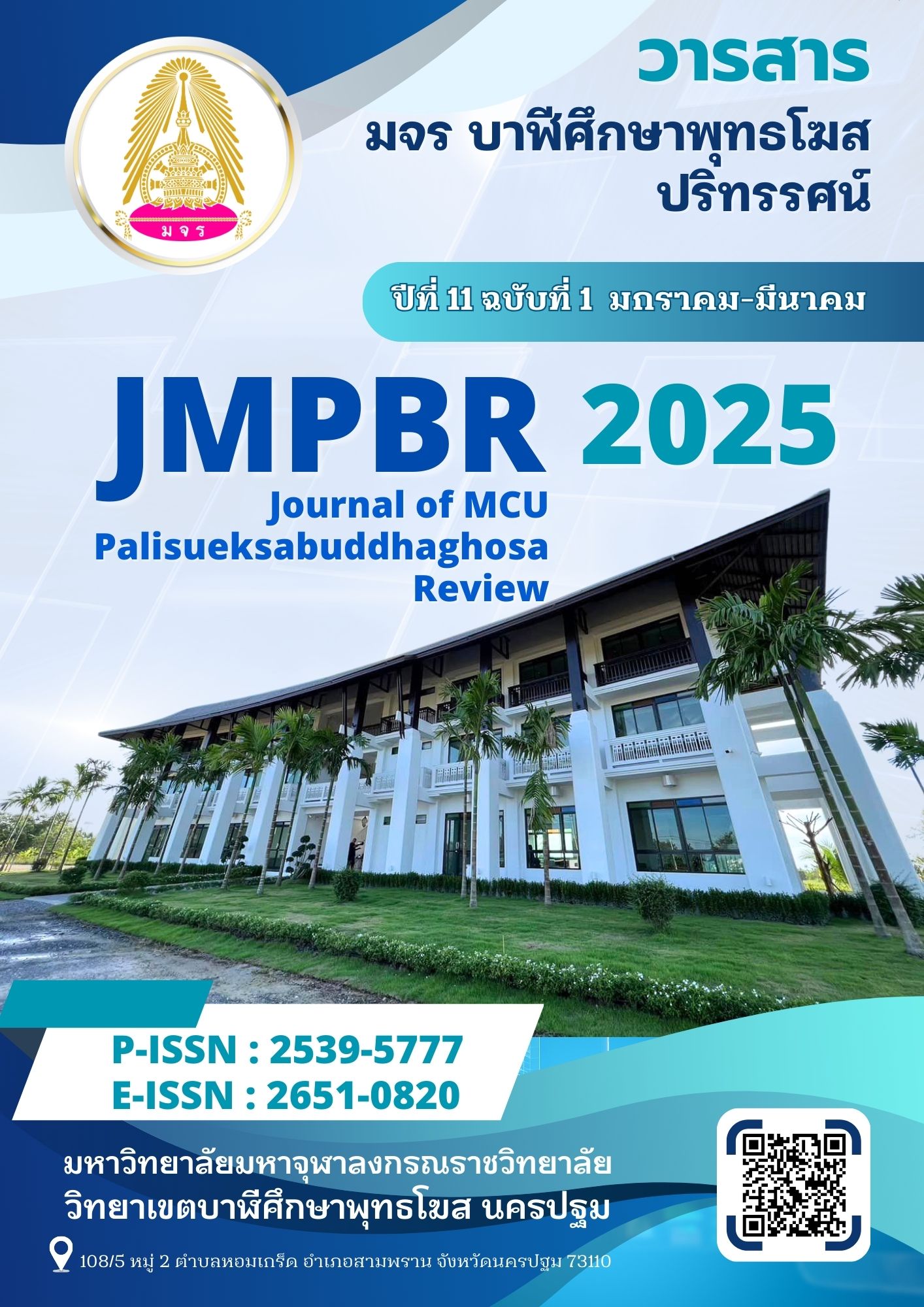PATH OF PROFICIENT (PAṬISAMBHIDĀMAGGA): INTEGRATION TO 4 NOBLE TRUTH BY INTERPRETATION OF TEACHING (DESANĀHĀRA6)
Main Article Content
Abstract
This research has 3 objectives: 1) to study the background and core doctrinal content of the Paṭisambhidāmagga scripture, 2) to examine the principles of Desanāhāra 6 and the Four Noble Truths, and 3) to integrate the doctrinal principles of the Paṭisambhidāmagga into the Four Noble Truths through Desanāhāra 6. The research was conducted by collecting data from the Tipiṭaka, commentaries, sub-commentaries, and other relevant scriptures, then compiling and presenting the findings in a descriptive manner.
Research Findings: 1) The Paṭisambhidāmagga is attributed to Venerable Sāriputta and is a Pāli canonical text within the Khuddaka Nikāya of Suttanta Piṭaka. It is regarded as the first meditation manual and later served as a foundational model for subsequent meditation texts, such as the Vimuttimagga composed by Upatissa Thera and Visuddhimagga by Buddhaghosa Thera. The Paṭisambhidāmagga presents doctrinal concepts through 30 analytical discourses or Kathā, categorized into 3 sections: Mahāvagga including 10 topics on major doctrines, Samatha and Vipassanā including 10 topics on concentration and insight meditation, Paññā or 10 topics on wisdom, 2) Ariyasacca is the most essential truths, found by the Buddha. The Buddha is called Sammāsambuddha because he realized and taught others to realize the Four Noble Truths. Sāriputta Thera explains the term Buddho as follows: "One is called the Buddha because he has realized the truths." "One is called the Buddha because he leads beings to realize the truths." The term Sacca refers specifically to the Four Noble Truths. According to the Nettippakaraṇa Aṭṭhakathā, the Buddha’s teachings are inseparably connected to the Four Noble Truths, as stated: "The Dhamma taught by the Buddha is always rooted in truth. There is not a single verse of his teachings that is separate from the Four Noble Truths." 3) The study demonstrates that the Paṭisambhidāmagga serves as an essential meditation guide in accordance with Theravāda Buddhism. It possesses unique characteristics that make it a reliable reference for all meditation traditions. The comprehensive nature of its discourses, their interconnectedness, and depth of analysis render it an invaluable preservation tool for the authentic meditative teachings of Theravāda Buddhism.
Article Details

This work is licensed under a Creative Commons Attribution-NonCommercial-NoDerivatives 4.0 International License.
Copyright Notice
The content and information in the articles published in Journal of MCU Palisueksabuddhaghosa Review, are regarded as opinions and responsibilities of article author only. It definitely does not mean that the editor must agree or share any responsibility to the author.
Articles, information, content, figure etc. that have been published in the Journal of MCU Palisueksabuddhaghosa Review is considered as the copyright of the Journal. If any individual or organization will to bring any parts of article for promote or to do anything, must be licensed only in official form from the Journal of MCU Palisueksabuddhaghosa Review.
The content and information in the articles published in Journal of MCU Palisueksabuddhaghosa Review, are regarded as opinions and responsibilities of article author only. It definitely does not mean that the editor must agree or share any responsibility to the author.
Articles, information, content, figure etc. that have been published in the Journal of MCU Palisueksabuddhaghosa Review is considered as the copyright of the Journal. If any individual or organization will to bring any parts of article for promote or to do anything, must be licensed only in official form from the Journal of MCU Palisueksabuddhaghosa Review.
References
พระคันธสาราภิวงศ์. แปลและอธิบาย. เนตติอรรถกถา. นครปฐม: ห้างหุ้นส่วนจำกัด ซีเอไอเซ็นเตอร์, 2551.
พระพรหมคุณาภรณ์ (ป.อ.ปยุตฺโต). แก่นแท้ของพระพุทธศาสนา. กรุงเทพมหานคร: อักษรสัมพันธ์, 2550.
________. พจนานุกรมพุทธศาสน์ ฉบับประมวลศัพท์. พิมพ์ครั้งที่ 21. กรุงเทพมหานคร: สำนักพิมพ์ผลิธัมม์, 2556.
________. พจนานุกรมพุทธศาสตร์ ฉบับประมวลธรรม. พิมพ์ครั้งที่ 17. กรุงเทพมหานคร: สำนักพิมพ์จันทร์เพ็ญ, 2552.
พระพุทธโฆสาจารย์. คัมภีร์วิสุทธิมรรค. แปลโดย สมเด็จพระพุฒาจารย์ (อาจ อาสภมหาเถร). พิมพ์ครั้งที่ 11. กรุงเทพมหานคร: บริษัท ธนาเพรส จำกัด, 2556.
พระภาวนาพิศาลเมธี วิ. (ประเสริฐ มนฺตเสวี). เอกสารประกอบการสอน รายวิชาวิปัสสนาภาวนา. นครปฐม: ศูนย์บัณฑิตศึกษาวิทยาเขตบาฬีศึกษาพุทธโฆส. 2558.
พุทธทาสภิกขุ กองตำราคณะธรรมทาน. อริยสัจจากพระโอษฐ์ภาคปลาย. พิมพ์ครั้งที่ 2.กรุงเทพมหานคร: ธรรมทานมูลนิธิ, 2527.
มหาจุฬาลงกรณราชวิทยาลัย. พระไตรปิฎกภาษาบาลี ฉบับมหาจุฬาเตปิฏกํ 2500. กรุงเทพมหานคร: โรงพิมพ์มหาจุฬาลงกรณราชวิทยาลัย, 2535.
________. พระไตรปิฎกภาษาไทย ฉบับมหาจุฬาลงกรณราชวิทยาลัย. กรุงเทพมหานคร: โรงพิมพ์มหาจุฬาลงกรณราชวิทยาลัย, 2539.
________. เนตฺฺติิ-เปฏโกปเทสปกรณํํ. กรุุงเทพมหานคร: โรงพิิมพ์์วิิญญาณ, 2540.
________. เนตฺฺติิอฏฺฺกถา. กรุุงเทพมหานคร: โรงพิิมพ์์วิิญญาณ, 2539.
________. อรรถกถาภาษาบาลี ฉบับมหาจุฬาอฏฺกถา. กรุงเทพมหานคร: โรงพิมพ์มหาจุฬาลงกรณราชวิทยาลัย, 2532.
________. อรรถกถาภาษาไทย ฉบับมหาจุฬาลงกรณราชวิทยาลัย. กรุงเทพมหานคร: โรงพิมพ์มหาจุฬาลงกรณราชวิทยาลัย, 2553.
________. ปกรณวิเสสภาษาบาลี ฉบับมหาจุฬาปกรณวิเสโส. กรุงเทพมหานคร: โรงพิมพ์วิญญาณ, 2539.
มหามกุฏราชวิทยาลัย. พระไตรปิฎกพร้อมอรรถกถาแปลชุด 91 เล่ม. กรุงเทพมหานคร: โรงพิมพ์มหามกุฏราชวิทยาลัย, 2541.
สุภีร์ ทุมทอง. อริยสัจ. กรุงเทพมหานคร: ขุมทองอุตสาหกรรมและการพิมพ์, 2553.
________. อัปปมาทธรรม. นนทบุรี: บริษัท ภาพพิมพ์ จำกัด. 2564.

